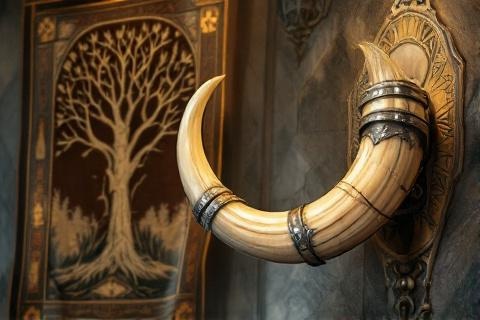
Horn of Gondor
Echoes of Valor
Ancient Heritage of the Great Horn

The Horn of Gondor was forged during the early days of the
Stewards' rule over Gondor, when the line of kings had been broken but the
realm's glory had not yet dimmed. During this period, the Stewards maintained
many of the ancient traditions and symbols of Gondor's power, with the Horn
becoming one of their most significant heirlooms.
Throughout the centuries of Gondor's history, the Horn passed from father to
firstborn son in an unbroken line of succession among the Stewards. This
tradition began with the first Ruling Steward and continued until the final days
of the Third Age, symbolizing both the authority and
responsibility carried by the heir to the Stewardship.
The original horn was taken from one of the legendary wild oxen of the eastern
regions of Middle-earth, massive beasts known for their
strength and rarity. These creatures were said to roam the vast plains beyond
Rhûn, and the hunting of such beings was considered a feat of great prowess.
Physical Description and Craftsmanship
The physical form of the Horn of Gondor reflected its noble origins, crafted
from the horn of a mighty wild-ox from the distant East. Its tips were adorned
with finely worked silver, showcasing the craftsmanship of Gondor's artisans who
enhanced its natural beauty with precious metal.
The horn bore intricate inscriptions in ancient characters, telling tales of
Gondor's history and displaying the proud symbols of the realm. These markings
included the Tree of Gondor and other heraldic devices that represented the
authority of the Stewards and the legacy of Númenor.
When sounded, the Horn produced notes of remarkable clarity and strength that
could carry across vast distances. The acoustics of the horn were legendary, as
its call could be heard leagues away, particularly in times of great need when
its sound seemed to gain supernatural strength.
The Horn's impressive size required it to be carried on a baldric, a specially
made shoulder strap that allowed the bearer to wear it diagonally across their
body. This method of carrying became part of the traditional regalia of the
Steward's heir, making the Horn instantly recognizable as a symbol of authority.
Powers and Properties

The Horn's remarkable acoustic properties allowed its call to travel incredible
distances across the lands of Gondor. In times of need, its sound could carry
for many leagues across plains, forests, and even mountains, serving as a vital
communication tool for the realm.
Historical records speak of the Horn's call being heard beyond the borders of
ancient Gondor, reaching as far as the edges of Rohan and the distant shores of
Anduin. This extraordinary range made it an invaluable tool for communication in
the vast territories of Gondor.
The people of Gondor learned to distinguish between different notes and calls of
the Horn, each carrying specific meanings. Some calls signaled danger, others
victory, and still others were used for ceremonial purposes, creating a complex
language of horn-calls understood throughout the realm.
Significance in Gondorian Culture
As the primary symbol of the Steward's heir, the Horn represented both the
authority and the responsibilities inherited by each successor. It served as a
tangible link between generations of leaders, each bearer adding to its
significance through their actions and service to Gondor.
The Horn became synonymous with Gondor's calls for aid, particularly in times of
dire need. When sounded in distress, it represented not just a plea for help but
also the honor and brotherhood between Gondor and its allies, especially the
realm of Rohan.
The Horn played a crucial role in both ceremonial functions and military
operations. During peaceful times, it announced important events and
celebrations, while in war, it rallied troops and coordinated movements across
battlefields.
Throughout Gondor, the Horn was regarded with deep reverence by all citizens. It
represented not only the authority of the Stewards but also the enduring spirit
of Gondor itself, serving as a reminder of the realm's ancient glory and
continued resilience.
The Horn's Role in Communication

Military commanders utilized the Horn's far-reaching sound to coordinate troop
movements across Gondor's vast territories. Its distinct calls could direct
armies, signal retreats, or announce reinforcements, making it an essential tool
in military strategy.
The Horn served as a sophisticated emergency signal system throughout Gondor's
domains. Watchers and guards stationed along borders and at key points could
recognize and relay its messages, creating an effective network of
communication.
The Horn's users developed an intricate system of different blast patterns, each
conveying specific tactical information. Short bursts might signal immediate
danger, while long, sustained notes could announce victory or call for general
assembly.
Famous Bearers Through History
Each generation of Stewards' heirs carried the Horn with pride and
responsibility, understanding its significance as both a practical tool and a
symbol of their authority. The Horn became an integral part of their identity
and duty to Gondor.
Among its most famous bearers was Vorondil the Hunter, who was said to have
hunted the wild ox from which the Horn was made. Other notable wielders included
Stewards who defended Gondor against various threats throughout its history.
The last bearer of the Horn was Boromir, eldest son of Denethor II, who carried
it during the War of the Ring. His bearing of the Horn marked the end of its
long lineage, though he proved worthy of its legacy through his valor.
Each bearer of the Horn contributed to its growing legend through their deeds
and sacrifices. Some used it to rally troops in desperate battles, others to
celebrate great victories, but all added to its reputation as a symbol of
Gondor's endurance.
The Final Call

The Horn's final call came at Amon Hen, where Boromir blew it in desperate need
as he fought to defend Merry and Pippin from an overwhelming force of Uruk-hai.
This last blast would become legendary in the annals of Gondor's history.
The sound of Boromir's final call was said to have carried all the way to Minas
Tirith, where his father Denethor heard its distant echoes. This supernatural
occurrence spoke to the Horn's mystical nature and its deep connection to
Gondor's fate.
After Boromir's heroic last stand, the Horn was found cloven in two beside his
body, a physical representation of the breaking of the line of Stewards and the
end of an age in Gondor's history.
Legacy and Memory
The broken pieces of the Horn were brought back to Minas Tirith and presented to
Denethor II, who was deeply affected by this tangible evidence of his eldest
son's fall. The fragments became a poignant reminder of Boromir's sacrifice and
the price of defending Gondor.
In death, both Boromir and the Horn became powerful symbols of nobility and
sacrifice in Gondor's culture. The broken Horn represented not just the loss of
Boromir, but also the end of the old order and the coming of a new age.
The tale of the Horn of Gondor lived on in songs and stories throughout the
Fourth Age and beyond. Minstrels sang of its clear call, its
noble bearers, and its final breaking, ensuring that future generations would
remember its significance in Gondor's history.
